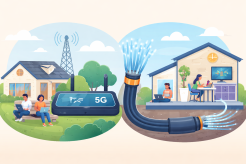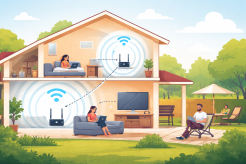How to Fix Disturbing Wi-Fi Security Flaws?

It's likely that a technician from your internet service provider came out to install your modem and router. Outside of installing new devices, you connected your laptop or smartphones and never gave the network a second thought. If this is the case, there may be various wifi security flaws that need to be addressed immediately in order to repel hackers and prevent unauthorized access to your network.
Although if you set up a router that you bought, you should double-check that it's working properly and that you're not allowing anyone to download whatever they want using your network, which may result in federal authorities showing up at your house.
Related: How to Protect yourself from the Dangers of Public Wi-fi
Wi-fi security flaws and how to fix it
You leave yourself vulnerable to hackers if you use the router's default login.
The public (internet) and your devices are both addressed by your router (home network). If you never updated the out-of-the-box default login info, such as "admin" and "password," anyone can obtain access to your router—whether remotely or locally.
Furthermore, even if routers do not employ the "admin" and "password" combination, anyone can simply find all router default login data on the internet.
Solution
We show you how to change the default username and password on your router by showing you how to get in. To establish and store unique login credentials, make sure to utilize a password manager.
WPS makes your network vulnerable to hackers.
WPS (Wi-Fi Protected Setup) allows devices to connect to your wireless network without the need for a password the first time they use it. You can either use an eight-digit PIN or push a button on the router.
However, the ease of usage has a downside: WPS is subject to brute-force assaults, which are a trial-and-error method of determining login information. A hacker may figure out the first four digits of the PIN (there are only 11,00 potential permutations) before moving on to the following four. The PIN may be cracked in 4 to 10 hours using free tools that can be downloaded from the internet.
Solution
Updating your firmware and disabling WPS are your greatest defenses (if possible). On routers from other manufacturers, the technique for removing WPS varies, however here are instructions for NETGEAR products as an example:
- Enter router login dot net into the address bar of a web browser.
- Fill in your login information.
- Advanced Setup should be selected.
- Select Wireless Settings from the menu.
- Check the box next to Disable Router's PIN under WPS Settings. Uncheck the box next to Enable Router's PIN if that option isn't accessible.
Outdated firmware exposes you to hacking.
Firmware is a type of software that controls and manages hardware. It's the operating system that tells the router's processor how to do things like relay internet traffic and assign private addresses, among other things. But, like any other operating system, firmware isn't perfect—always there's a flaw in the coding that allows intruders to gain access to your network.
The good news is that software experts are always adding new upgrades to fill these gaps. The bad news is that your router's firmware may not be updated to the most secure version, leaving your network vulnerable to a remote assault.
A hacker, for example, could alter your router settings to send all of your internet traffic to malicious websites. They might also take control of your machines and steal important data such as bank account logins, or they could use it to spread malware to other infiltrated networks.
Solution
Access the router's settings using a mobile app or a web browser, depending on the manufacturer, to verify the firmware status.
The Linksys mobile app, for example, has an option under Network Administration that turns on and off automatic firmware updates. The user interface on the web is unique.
The steps below are for a Linksys router; however, the process may vary depending on your model.
- Open a browser and type in the IP address of your router. We provide advice on how to find your router's IP address, but the information is usually printed on the router itself.
- On the router's login screen, enter your credentials.
- On the left, select Connectivity.
- The Basic tab is selected by default when the Connectivity section loads. If it isn't already checked, tick the box next to Automatic under Router Firmware Update.
By ticking this box, the router will automatically update its firmware. You can click the Check for Updates button if you like, but you'll probably get a notice saying "no updates found."
A simple or non-existent password invites intruders and hackers.
Using a password that is easily guessed, such as a child's name, a pet's name, or your address, is easy, but it leaves your network susceptible to hackers and other unscrupulous individuals roaming around outside. Furthermore, not using a password to secure your network is terrible news—you might as well put up a giant Times Square billboard proclaiming, "Get Your Free Access Here!"
Solution
Create a strong password for your network with a password manager, then share it as needed with built-in features for Android, iOS, and iPadOS.
Guests have the option of downloading unlawful stuff.
There's nothing wrong with granting access to your home's network to friends and family members who aren't related to you. What you don't want is for your friends and relatives to use your internet connection to download questionable information. You don't want the FBI showing up at your house, and that's exactly what could happen if guests download whatever they want.
Solution
Create a "guest" link for anyone who resides outside of your house. This subnetwork keeps visitors off your main connections and restricts the number of devices that can connect. You're also not disclosing the password to your main network.
You may limit bandwidth, block websites, define connection times, and more per device with a guest network. How to set up a guest Wi-Fi network is covered in a separate guide.
Access to adult content is unrestricted for children.
For parents, the internet is both a benefit and a curse. On the one hand, children and teenagers can access the information they require. They can play online games with their buddies and attend classes from afar. Unfortunately, all they need is a single URL to access unsuitable and unpleasant content.
Solution
To protect your children and teenagers, we provide instructions on how to set up parental controls on a router. You may specify hours of use, block and allow specific sites, and block and allow specific devices here.
Parental controls are handled by some routers through a separate portion of the router's interface. You can also manage the connection by clicking on a device or utilize profiles to configure parental restrictions for each child.
Hackers are attracted to remote access.
You can use remote access to access the router's interface from anywhere in the world, such as a hotel room in another state. Anyone with access to your router and default or weak password can obtain access from afar and change the settings to redirect all of your internet traffic to malicious websites.
Solution
To disable this capability, look for Remote Access controls in the router's administration area. If you plan to travel while the family remains at home, you can turn it back on, then turn it off when you return.
Your router's model number is broadcast.
You'll probably recognize some of the names on the resultant list if you click or press on your device's Wi-Fi icon: Linksys, NETGEAR, and so on. The default Service Set Identifier (SSID) name, which is the public name of the wireless network, was never altered by the owners of these routers.
What's the big deal about that? Anyone who sees the words "Linksys" or "NETGEAR" knows who owns one of these routers. You may simply find the default SSID and login pair on the internet and use that information to get access to that router and obtain the network's login credentials.
Solution
In general, you should modify the network name from the default to something else. You can rename it to anything you like, whether it's a basic name or a label designed to irritate your neighbors. It's entirely up to you whether you want to have a good time or be sensible.
You can change the SSID either through the manufacturer's mobile app or through the web portal. As an example, the following procedures use a Linksys router.
- Make a connection to the router.
- Open a browser and type in the IP address of your router (or LinksysSmartWiFi.com).
- On the left, select Wi-Fi Settings.
- In both Wi-Fi Name slots, type a new name (one each for 2.4 GHz and 5 GHz).
Related Posts

Wed, Jan 7, 2026 4:53 AM
cheap internet offersHow to Get Cheap Internet Without Sacrificing Speed
Learn how to get affordable internet without sacrificing speed. Compare providers, optimize your network, and save on your monthly bill with smart strategies.

Wed, Jan 7, 2026 3:02 AM
Regulations Technology Broadband InstallationWhy Choosing a Local Internet Provider Just Makes Sense
Explore the benefits of local internet providers—fast support, transparent pricing, reliable connections, and personalized service in your area.

Tue, Jan 6, 2026 10:57 PM
SubscriptionHow to Use Cloud Storage Without Using Too Much Data
Learn how to use cloud storage efficiently without consuming too much data. Simple tips to save bandwidth while keeping your files accessible online.

Tue, Jan 6, 2026 3:25 AM
SubscriptionHow to Decide Between Mobile Broadband and Fiber for Your Home
Learn how to choose between mobile broadband and fiber internet for your home with tips on speed, reliability, cost, and household needs.

Mon, Jan 5, 2026 2:44 AM
Technology WifiWiFi Extenders Explained: A Simple Way to Fix Dead Zones at Home
Learn how WiFi extenders improve home internet coverage, fix dead zones, and support multiple users with better connectivity indoors and outdoors.